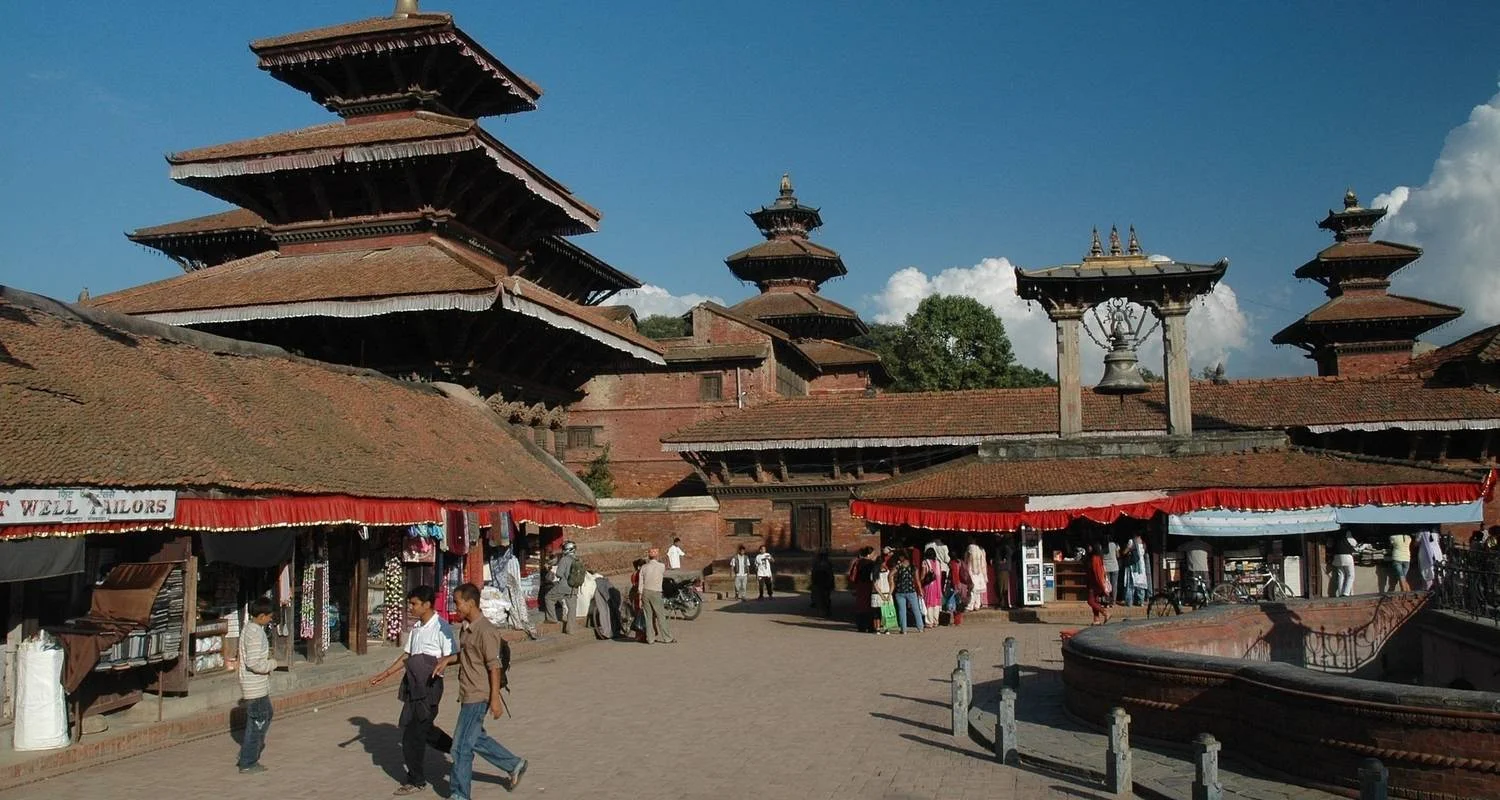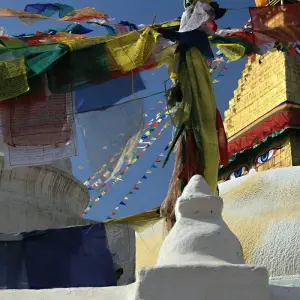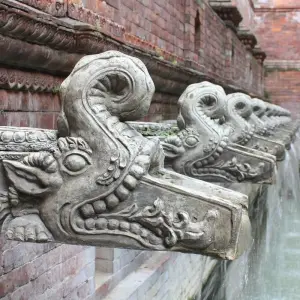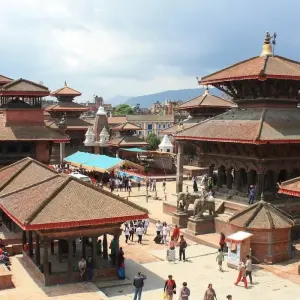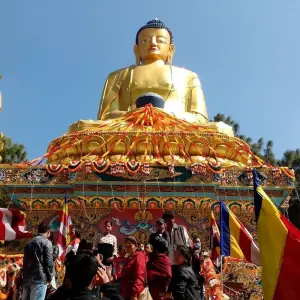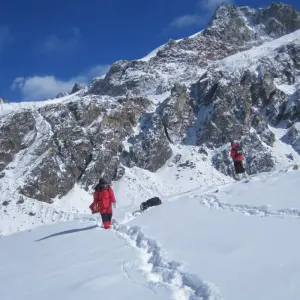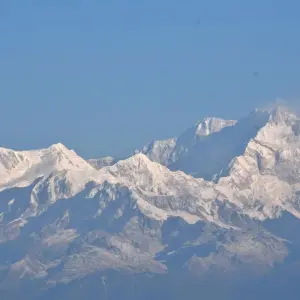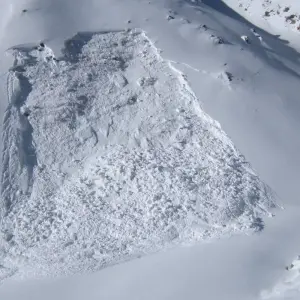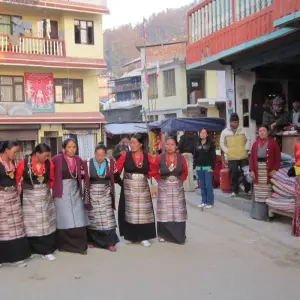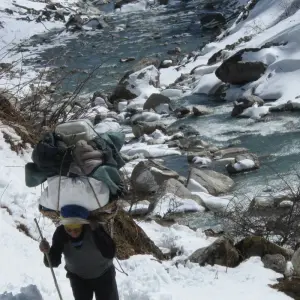Our representative will meet you at the Tribhuwan International Airport, Kathmandu and you will be transferred by private coach to the hotel. In the hotel we will discuss with the necessary equipment and the trekking permit. Overnight stay at a hotel.
Itinéraire
Deuxième plus haut sommet du Népal et troisième plus haut sommet du monde, le Kanchenjunga est situé dans l'angle nord-est du district de Taplejung. Ses crêtes principales forment une frontière naturelle entre deux États, ainsi qu'une ligne de partage des eaux pour plusieurs rivières importantes. La frontière tibétaine se trouve à 12 miles au nord du Kanchenjunga. Elle longe la principale ligne de partage des eaux de l'Himalaya, séparant le plateau aride du Tibet au nord et le pays plus fertile et arrosé par les pluies au sud.
Le Kanchenjunga est une montagne d'une grande beauté. Il est suffisamment grand pour posséder ses propres glaciers qui rayonnent depuis ses différents sommets. Bien qu'entouré de nombreux sommets, les glaciers qui s'écoulent jusqu'à la lisière des forêts tropicales sont la propriété incontestée du Kanchenjunga. C'est la seule montagne qui montre sa gloire au monde entier. Seuls ceux qui peuvent s'offrir le temps et les dépenses nécessaires pour pénétrer dans les lointaines forêts d'où elles jaillissent peuvent admirer les gloires de l'Everest, mais le Kanchenjunga est facilement visible depuis n'importe quel habitant des contreforts inférieurs.
Le Kanchenjunga ne se contente pas de briser la force de la mousson, il protège dans une large mesure le principal bassin hydrographique au nord de ses assauts. Il en résulte une variation extraordinaire du paysage et du climat sur une petite surface. La colline sèche, presque poussiéreuse, à la tête de la vallée de Lhonak, la chaîne du Dodang Nyima et le plateau du Tibet au-delà forment un contraste frappant avec la vallée qui rayonne vers le sud depuis le Kanchenjunga, car il s'agit d'un pays sec, brun rougeâtre, avec un niveau de neige sensiblement plus élevé et des glaciers considérablement plus petits que ceux du Kanchenjunga et de ses voisins immédiats. Il n'y a probablement aucune autre montagne où l'alpiniste est exposé à de plus grands dangers que sur le Kanchenjunga, car il doit non seulement faire face aux avalanches de glace, mais aussi à des conditions météorologiques généralement incertaines.
En gros, il y a quatre lignes d'approche principales du Kanchenjunga : la vallée de la rivière Tamor au Népal, passant par Ghunsa et Kangbachen, la vallée de Yalung au Népal, la vallée de la rivière Teesta au Sikkim, et la vallée de Talung également au Sikkim. Entre les vallées de Yalung et de Talung se trouve également la rivière Rangit, qui prend sa source dans les glaciers de Kabru, à 2400 pieds d'altitude, l'un des sommets les plus éloignés du Kanchenjunga, au sud. La superficie du Kanchenjunga représente 55% de la superficie du district de Taplejung et 1,40% de la superficie totale du pays. Ses 65% sont couverts par l'Himalaya, les rochers et la glace des montagnes et les 45% restants sont couverts par des forêts, des arbustes, de l'herbe et des terres agricoles. Le climat de cette région varie de la mousson subtropicale à basse altitude à l'alpin dans les zones plus élevées.
Programme du circuit
Jour 1 : Arrivée à Katmandou
Point de départ
Tribhuvan International Airport (KTM) त्रिभुवन विमानस्थल, त्रिभुवन विमानस्थल, Kathmandu, Bagmati, Nepal
Jour 2 : Visite ou journée libre à Katmandou
Kathmandu free day or you can make sighteeing yourself in valley includes several Hindu temples including of Pashupatinath, listed by UNESCO in World Heritage Site and the largest Buddhist Stupa, Bouddhanath. You can also visit the Monkey Temple Swyambhunath, built some 2000 years ago, and visit Patan, city of fine arts. In theevening you will be meeting with your trekking guide, checking the equipments and further discussion.
Jour 3 : Vol pour Bhadrapur (2059m) et bus pour Taplejung
From Kathmandu we will take our flight for Bhadrapur. which takes about 55 min. It lies in northeastern part of Nepal. Bharatpur to Taplejug you will take local bus and over night Taplejung Bazzar.
Jour 4 : Départ en jeep pour Tapethok et trekking jusqu'à Sekathum (1640 m).
We begin the trek by driving to Tapethok, which takes about 3-4 hours. After checking in at the KCAP checkpoint, we pass several villages. Reaching Pembu, it is anuphill climb for about two and a half hours to sekathum. There is a Near by KCAP headquarters in Lelop, and various grocery stores and tea shops. We will stay in a homestay here.
Jour 5 : Trek de Sekathum à Amjilosa (2510m)
From Sakathum to Amjilosa it takes almost 5 hours. Initially our trek will be easy as we move through the flat land. Then our trek takes a form of steep uphill when you climb towards Amjilasa, a small rural area with few inhabitants and local shops known as “Bhattis," or tea shops. Overnight stay at guesthouse.
Jour 6 : Trek d'Amjilosa à Gyabla (2730m)
The trek to Gyabla (2730m) takes 5-6 hours. The path is quite interesting as we pass through the jungle. Most of the people who are living in this area follow Buddhist culture. Overnight stay at guesthouse.
Jour 7 : Trek de Gyabla à Ghunsa (3695m)
To reach Ghunsa (3695m) as a trekking spot takes six hours. On the way, we pass through the jungles. The track leads to the settlement of natives. Here, many people are engaged in business like import and export in Tibet. In winter season they go to India for business. Overnight stay at guesthouse.
Jour 8 : Trek de Ghunsa à Khambachen (4099m)
It takes about 6 and a half hours to reach Khambachen (4099m) from Ghunsa.
Kambachen is dense settlement of people who follow Tibetan culture. You will be fascinated with the art and architecture of Khambachen, which is inspired by Tibetan cultures. Overnight stay at guesthouse in Khambachen.
Jour 9 : Exploration de Khambachen, journée de repos (4099m)
We spend today exploring the Khambachen as there are different things to experience here that can be only done by walking. We will spend the remaining day enjoying the place and resting for the trip ahead. Overnight stay at guesthouse.
Jour 10 : Trek de Khambachen à Lhonak (4785m)
Climb through the rocky boulder fields on the hillside along the riverbank until we reach a waterfall. Cross the bridge to Ramtang, and cross more small landslides before finally arriving to Lhonak. Overnight stay at guesthouse.
Jour 11 : Trek de Lhonak à Pangpema (5143m)
At morning start to treks to North base camp (5243m). The stunning peak which is considered as a main peak of Kanchenjunga and landscape of remaining peaks which make one of the largest mountains in the world.An interesting thing to see is the water that flows all the time from the gorge.You should trek back downward till Lhonak where you are delighted by gazing Mountains and Yaks. Overnight in Lhonak.
Jour 12 : Trek de Lhonak à Ghunsa
Now we descend by traveling through the jungle along the Kambachen River. In some places, we can see the mani walls and prayer flags hanging over the trees. At one point, we'll cross a wooden bridge.
Jour 13 : Trek de Ghunsa au col de Selele (4043m)
We camped slightly before Mirgin La Pass. After a steep ascent through rhododendron forests, we reach Tamo La Pass, a ridge festooned with payer flags. As we go towrads another ridge crest, rising to 4115m, we have a nice view of Ghunsa River snaking along the north Kanchenjunga glacier. Continue to scramble up, enjoying the sight of Kanchenjunga west. Overnight at tea house.
Jour 14 : Trek du col de Selele à Tsaram (3870 m)
After crossing the Mirgin La ascent to Sinon La (4660m) and another pass at 4700m, the tril descends towards Simbhu Khola Valley. It is an excellent place to organize an extra excursion. Visit Ramche Village (4620m) and into the Yalung glacier, towards its south base camp.
Jour 15 : Trek de Tsaram à Ramche (5225m)
A rocky loose path follows the stream and climbs up to some mani walls (stones carved with Buddhist prayers). Rathong (6678m) and Kabru Dome (6700m) loom at the head of the valley. Climbing further alongside the moraine of Yalung Glacier to where the valley opens up as we approach Yalung at 4260m. Our trek climbs further along the moraine to a lake and a big meadow at Ramche. The view is dominated by the spectacular peak of Rathong. Herds of blue sheep live on the cliffs above our campsite.
Jour 16 : Trek de Ramche à Tsaram (3725m)
After breakfast, we head back the same way we came to Tsaram, enjoying the scenery along the way.
Jour 17 : Trek de Tsaram à Trongden
We follow our way along the Simbua Khola to a campsite at Lamite Bhanjyang. There is a pond nearby at 3410m, which is a nice place to set up camp, although sometimes there may be a water shortage there. Overnight Trongden.
Jour 18 : Trek de Trongden à Yamphudin (2090m)
Hike to Yamphudin (2080m) acquires 8 – 9 hours. The hiking starts after you take a walk into the jungles. Seeing the landslides on the way do not get frustrated as yamphudin trek is a rejoiced trek where you can see mixed and diverse communities of people; belonging to Limbu, Sherpas, Gurung and Rai ethnic groups. In the midst of the village you can see the fields of rice and corn. Moreover, there is a village with schools and shops where they supply in a negotiable price. Overnight stay in guest house.
Jour 19 : Trek de Yamphudin à Khebang
In the beginning, you descend crossing the Omje Khola up to halfway. Then you begin ascending through a jungle of cardamom and orchid plants. You pass a small village where you can find different human settlements, small thatched roof houses and local shops with minimal supplies. From here, the trail steeply ascend to Khebang Danda before descending to Khebang village. Khebang is a comparatively big village where the local people follow the Hindu and Buddhist faiths.
Jour 20 : Trek de Khebang à Hapu Khola
The trail starts descending to Jorepul and then begins to ascend. We will also trek along flat and low land, crossing paddy fields and thatched roof houses. There are many villages along the way where we can buy some snacks or lunch.
Jour 21 : Jeep locale de Hapu Khola à Ilam Bazaar 5-6 heures de route
After breakfast, we take a jeep ride from Hapu Khola to Ilam Bazaar. Overnight in Ilam Bazaar.
Jour 22 : Vol d'Ilam ou de Bhadrapur vers Katmandou.
you take the flight back to Kathmandu, you will arrive the same day and the trip ends. Either way, we will have a celebratory dinner for you in the evening that you return to Kathmandu.
Jour 23 : Départ du Népal (si le vol a été pris)
We will transport you to the airport. Thanks for trekking with Adventure Himalayan Travels. We look forward to seeing you again!
Point d’arrivée
Tribhuvan International Airport (KTM) त्रिभुवन विमानस्थल, त्रिभुवन विमानस्थल, Kathmandu, Bagmati, Nepal
Détails du circuit
accommodation
- Trois nuits d'hébergement dans un hôtel de catégorie 3 étoiles à Katmandou.
- 19 nuits et 20 jours de nourriture et d'hébergement pendant le trek (lodge local)
transport
- Arrivée et départ des transports en véhicule privé.
- Bhadrapur à Taplejung et Taplejung au point de trekking en Jeep locale partagée.
- Hapu Khola à Ilam en jeep locale et Ilam à Bhadrapur.
insurance
- Inclure l'assurance du guide et du porteur
optional
- Nuit supplémentaire à Katmandou : 50 USD pour une chambre double et 45 USD pour une chambre simple avec petit-déjeuner.
- Si vous souhaitez faire du tourisme à Katmandou, dans les nombreux sites de la ville classés au patrimoine mondial de l'UNESCO, il vous en coûtera 50 USD par voiture.
others
- Frais du système de gestion de l'information des randonneurs (TIMS)
- Permis du parc national du Kanchenjunga et permis de la zone réglementée du Kanchenjunga
- Équipement et vêtements pour les porteurs et le personnel
- Équipement (sac de couchage, veste en duvet, trousse de premiers secours, oxymètre, carte, etc.)
- Assurance pour tout le personnel et les porteurs.
- Certificat d'accomplissement de trekking fourni
- Un t-shirt Adventure Himalayan gratuit
others
- Visa pour le Népal - Entrée multiple 30 jours - 50 USD (détails sur la page des visas)
- Vol international
- Assurance pour les clients (évacuation par hélicoptère, etc.)
- Déjeuner et dîner à l'hôtel à Katmandou
- Frais de chargement électronique dans les maisons d'hôtes pendant le trekking
- Boissons alcoolisées, bonbons, etc.
- Hébergement et repas supplémentaires en dehors de l'itinéraire
- Équipements et vêtements personnels (disponibles à la location)
- Pourboires, toutes les dépenses encourues en cas d'évacuation d'urgence ou de blocage de la route pour quelque raison que ce soit, boissons de table, collations pendant la marche.
guide
- Guide de trekking expérimenté et serviable (formé par le ministère du tourisme)
- Porteur portant au maximum 20 kg et un porteur pour deux personnes.
Bon à savoir
Devise
Nepalese Rupee
Népal

